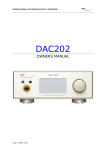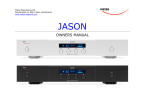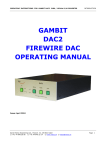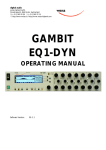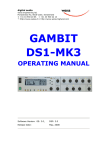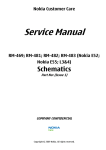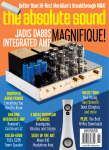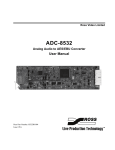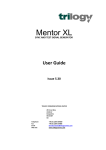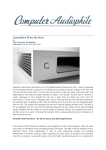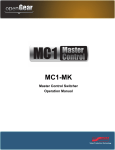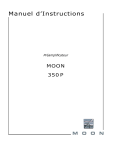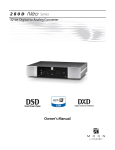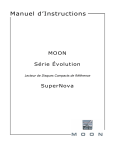Download OWNERS MANUAL
Transcript
Weiss Engineering Ltd. Switzerland www.weiss-highend.com MEDUS OWNERS MANUAL OWNERS MANUAL FOR WEISS MEDUS D/A CONVERTER INTRODUCTION Dear Customer Congratulations on your purchase of the MEDUS D/A Converter and welcome to the family of Weiss equipment owners! The MEDUS is the result of an intensive research and development process. Research was conducted both in analog and digital circuit design, as well as in signal processing algorithm specification. On the following pages I will introduce you to our views on high quality audio processing. These include fundamental digital and analog audio concepts and the MEDUS converter. I wish you a long-lasting relationship with your MEDUS. Yours sincerely, Daniel Weiss President, Weiss Engineering Ltd. OWNERS MANUAL FOR WEISS MEDUS D/A CONVERTER TABLE OF CONTENTS 4 The MEDUS D/A Converter 4 Features 7 Operation 12 Technical Data 15 A short history of Weiss Engineering 16 Our mission and product philosophy 17 Advanced digital and analog audio concepts explained 17 Jitter Suppression, Clocking 19 Up-sampling, Oversampling and Sampling Rate Conversion in General 22 Reconstruction Filters 22 Analog Output Stages 23 Dithering 25 Contact 26 Addendum for the FireWire option 33 Addendum for the ST Glass Fiber input option OWNERS MANUAL FOR WEISS MEDUS D/A CONVERTER THE MEDUS D/A CONVERTER The MEDUS is a State Of The Art D/A Converter which handles PCM as well as DSD signals. Both digital and analog sections are designed with great care for all the details which make the MEDUS a truly remarkable DAC. Features Inputs: There are three AES/EBU inputs on XLR connectors, one on Toslink (optical), three RCA connectors, one USB connector. The accepted sampling frequencies are 44.1, 48, 88.2, 96, 176.4 or 192 kHz. The USB input also accepts DSD Signals. Sampling frequencies of 88.2kHz and higher can also be fed using the dual wire scheme, i.e. one cable per channel. Up-sampling: Signals at 44.1 or 48 kHz are up-sampled in the MEDUS’ DSP chip, using our own studio quality up-sampling algorithms. Thus the DAC chip always receives signals at a 88.2kHz minimum sampling rate. Synchronization: Several signal re-clocking schemes are combined for extremely high jitter attenuation, making the MEDUS virtually immune to jitter over a very wide bandwidth. Converters: The DAC chip up-samples the input signal to about 1.5MHz. Four D/A conversion channels are used per audio channel, resulting in exceptional performance specifications. The I/V conversion after the DAC chip uses two of our own discrete OPAMPs (the OP1-BP) per channel. OWNERS MANUAL FOR WEISS MEDUS D/A CONVERTER Outputs: Our discrete OP-AMPs are also used in the output stage, two per audio channel for a differential output. Output levels can be set between –4.0dBu and +27.0dBu (6dB less on asymmetrical outputs). The level setting is done in 1dB steps via a rotary switch at the back of the unit. Both outputs are set to the same level at any time. The outputs are symmetrical on XLR connectors and asymmetrical on RCA connectors. No sound degrading servo mechanisms are used. The Weiss OP1-BP discrete OP-AMP Power Supply: A powerful non-switching power supply is used. All sensitive voltages have their own regulators which are separated between left and right channels. The result is an analog output free of "digital noise" and channel crosstalk. The power switch activates a semiconductor relay which only switches on or off at zero crossings of the mains voltage. This assures a glitch free power switching. OWNERS MANUAL FOR WEISS MEDUS D/A CONVERTER Mechanical Design: The MEDUS employs a twin metal frame. The inner chassis is made of steel and acts as a very effective shield against electrostatic and electromagnetic radiation. The outer frame is made of massive anodized aluminium for additional shielding, resulting in optimal heat convection and beautiful looks. Front panel controls: • Four switches with corresponding blue LEDs are used for selecting one out of four input sources. • A display. • A power switch. Back panel elements from left to right: • Analog outputs on XLR and RCA connectors with output level switch. • Digital inputs 1 – 4 (three XLR, three RCA, one Toslink, one USB connector). • Mains connector with fuses and voltage selector. OWNERS MANUAL FOR WEISS MEDUS D/A CONVERTER Operation Unpacking and Setup of the MEDUS Carefully unpack the MEDUS. The following items should be enclosed: • The MEDUS D/A Converter unit • The MEDUS Remote Control unit • This Owner’s Manual • A Certificate of Guarantee The MEDUS should be placed horizontally on a plane surface. Avoid putting any other equipment or any other material on top of the MEDUS as not to compromise the MEDUS’ heat convection system. Mains Connection Before connecting the mains cable make sure the voltage selector switch on the back of the unit (integrated into the mains connector) is set to the appropriate voltage. If this is not the case then open the mains selector lid with a strong screwdriver. The mains plug must not be plugged into the connector for that purpose. Now you see a black selector drum with appropriate voltages written in white letters. Remove this drum, turn it to the appropriate voltage and reinsert it. Now firmly close the lid again. Connect the MEDUS to the wall outlet with the mains cable. Driver installation For OSX (Apple) operating systems it is not necessary to install any driver for USB. For Windows based systems a driver is included on the CD in the MEDUS manual. OWNERS MANUAL FOR WEISS MEDUS D/A CONVERTER Input Source Connection, Selection and Synchronization Connect sources with sampling frequencies of 44.1, 48, 88.2, 96, 176.4 or 192kHz to the input connectors at the back of the unit. Note that there are a total of four inputs. The following connectors are available: Input # 1: one XLR and one RCA connector (use either XLR or RCA at a time, i.e. you may connect two sources simultaneously, but only one source unit must be switched on at a time). Input # 2: The same as Input # 1 applies here. Input # 3: one XLR and one USB connector (use either XLR or USB at a time, i.e. you may connect two sources simultaneously, but only one source unit must be switched on at a time). Input # 4: one TOSLINK (optical) and one RCA connector (use either TOSLINK or RCA at a time, i.e. you may connect two sources simultaneously, but only one source unit must be switched on at a time). The input source pushbuttons correspond to the four inputs as described above. Input # 1 (left) and Input #2 (right) can act as an input for sources supporting the two wire scheme, i.e. one cable per channel. The MEDUS automatically detects whenever such a source is connected to inputs #1 and #2 and switches to the appropriate conversion mode. In that mode both LEDs of input #1 and #2 are lit. The two wire scheme is used by some sources with sampling rates of 88.2kHz or higher. If a valid AES/EBU or S/PDIF formatted signal is present at the selected input, the display indicates the sampling rate and the word length (the number of active bits in a digital sample) of the input signal. If the format and/or the sampling frequency is not valid, the word “unlocked” is shown in the display. In that case the analog outputs are muted. The MEDUS automatically synchronizes to the incoming signal. If the sampling rate of the signal is not within a range of +- 80ppm of one of the nominal sampling rates (44.1, 48, 88.2, 96, 172.4, 192kHz) then the blue LED of the active input is flashing. The analog outputs are muted in that case. The states of all settings are stored in non-volatile memory, i.e. the actual input selection, volume control etc. are retained when powering the unit off. OWNERS MANUAL FOR WEISS MEDUS D/A CONVERTER Output Level and Output Connection Connect your preamplifier or power amplifier to the output connectors of the MEDUS. Use either the symmetrical (balanced) lines (XLR connectors) or the asymmetrical (unbalanced) lines (RCA connectors). Or both, if you need to feed two amplifiers. Symmetrical is preferred, provided your preamplifier supports symmetrical connection. The basic output level is set either via the rotary switch on the back panel or via the remote control “gain trim” switches. This level setting is done in the analog domain and is used to set a basic level such that the subsequent amplifier is operating at its preferred input level. If you use the remote control to change the basic output level press and hold the ALT key and then press the gain trim + or – keys to adjust the level. The display shows the maximum output level for both XLR and RCA outputs in dBu. The position of the switch on the back panel does not indicate the basic output level. The switch merely acts as a rotary encoder, i.e. rotating clockwise increases the basic level and vice versa. Use the back panel switch or the remote control to adjust the basic output level to a value which matches your amplifier. If your amplifier has a volume control, adjust the MEDUS output such that you get a normal listening level with the amplifier’s volume control set to about midway between minimum and maximum volume. Note, it is normal when after setting the basic output level the MEDUS output mutes again for a short time. OWNERS MANUAL FOR WEISS MEDUS D/A CONVERTER Remote Control The Remote Control allows to control the following parameters: - basic output level with the gain trim keys as described above output volume in the digital domain with 0.5dB steps over a range of 60dB. With the 0dB setting (maximum level) the volume control is bit transparent - output mute - up-sampling filter A/B selection - absolute polarity (0 / 180°) - input number 1…4 - display brightness A paper on the topic of digital level control (including sound examples) can be found here: http://www.weiss-highend.ch/computerplayback/Digital_Level_Control.pdf OWNERS MANUAL FOR WEISS MEDUS D/A CONVERTER Display The display shows the following parameters: - input number: 1…4 - input sampling rate: unlocked, 44.1, 48, 88.2, 96, 176.4, 192 kHz, DSD - input word length: 16, 20, 24 Bit (shown if an audio signal is present) - gain: 0…. –60dB in 0.5dB steps (shown inverse if mute is activated) - absolute polarity: no display / 180° - up-sampling filter type: A/B - basic output level: in dBu (shown during selection of the basic output level) OWNERS MANUAL FOR WEISS MEDUS D/A CONVERTER Technical Data Digital Inputs: (3) XLR connectors, (1) Toslink connector (optical) (3) RCA connectors (1) USB connector All inputs accept professional or consumer standard , i.e. accept AES/EBU or S/PDIF signals Sampling Frequencies: single wire scheme: 44.1, 48.0, 88.2, 96.0, 176.4 or 192kHz on any of the four inputs Sampling Frequencies: dual wire scheme: 88.2, 96.0, 176.4 or 192kHz on inputs 1 and 2 DSD: On USB input Sampling frequency tolerance: +-80ppm Maximum input word length: 24 Bits Analog Outputs: (2) XLR Connectors (2) RCA Connectors Servo-less, DC coupled, short circuit proof output circuitry Output impedance: < 100 Ohm Output level: variable from -4.0dBu to +27.0dBu balanced on XLR connectors (-10.0dBu to +21.0dBu unbalanced on RCA connectors) with 0dBFS input, in 1dB steps (-4dBu is 0.49V, +27dBu is 17.35V, -10dBu is 0.245V, +21dBu is 8.67V) Output stage: Discrete Class A OWNERS MANUAL FOR WEISS MEDUS D/A CONVERTER D/A Converter chip: Over-sampling sigma-delta converter Four converters per channel Synchronization: Synchronized via input signal Extremely efficient Jitter attenuation down to subsonic frequencies Sampling Frequencies: 44.1 kHz, 48.0 kHz, 88.2kHz, 96.0kHz, 176.4khz, 192kHz DSP algorithms: Up-sampling, jitter reduction Power: Mains Voltage: 100...120 / 200...240 Volt Fuse rating: 500 mA slow blow Power consumption: 80VA max. Power consumption in standby: 2VA max. OWNERS MANUAL FOR WEISS MEDUS D/A CONVERTER Measurements: The measurements below have been taken at the following conditions (unless noted otherwise): +24.0dBu output level (-3dBFS input level), 192.0kHz sampling frequency (fs). Frequency Response: Signal To Noise Ratio (SNR) @ -40dBFS input: @ fs = 44.1kHz: 0Hz ... > 20kHz: within +- 0.25dB > 129dB un-weighted (relative to full scale output) @ fs = 48.0kHz: 0Hz ... > 20kHz: within +- 0.25dB > 132dB A–weighted (relative to full scale output) @ fs = 88.2kHz: 0Hz ... > 30kHz: within +- 0.75dB @ fs = 96.0kHz: 0Hz ... > 30kHz: within +- 0.75dB Linearity: @ fs = 176.4kHz: 0Hz ... > 40kHz: within +- 0.75dB at 0 to -100dBFs input level: @ fs = 192.0kHz: 0Hz ... > 40kHz: within +- 0.75dB < +-0.05dB deviation from ideal Total Harmonic Distortion plus Noise (THD+N) ratio at -100 to -120dBFs input level: @ 1kHz: < +-0.2dB deviation from ideal < -112 dB @ -3 dBFS input (0dBFS = +27.0dBu) < -115 dB @ 0 dBFS input (0dBFS = +27.0dBu) Crosstalk: < -110dB, 0..20kHz OWNERS MANUAL FOR WEISS MEDUS D/A CONVERTER A SHORT HISTORY OF WEISS ENGINEERING After studying electrical engineering, Daniel Weiss joined the Willi Studer (Studer - Revox) company in Switzerland. His work included the design of a sampling frequency converter and of digital signal processing electronics for digital audio recorders. In 1985, Mr. Weiss founded the company Weiss Engineering Ltd. From the outset the company concentrated on the design and manufacture of digital audio equipment for mastering studios. Its first product was the modular "102 Series" system. After 23 years, this system is still up to date (24 bit / 96kHz) and is still being sold. Hundreds of Mastering Studios around the world use it every day. In the early nineties the „Gambit Series“ was launched, taking ergonomics and sonic quality to new heights. The „Gambit Series“ consists of stand-alone units like Equalizer, De-noiser / De-clicker, Dynamics Processor, A/D converter, D/A converter, Sampling Frequency Converter, Dithering etc. 40 bit floating point processors and sampling rates up to 96kHz are employed. In 2001 we have decided to enter the High-End Hi-Fi market which offers a comparable clientele to that of the Mastering Studios. Both consist of critical and discerning listeners, who are in constant search for the best audio reproduction equipment or the best audio tools respectively. Our list of clients includes big names, like SONY, BMG, EMI, Warner, Hit Factory, Abbey Road, Teldec, Telarc, Unitel, Gateway Mastering (Bob Ludwig), Bernie Grundman Mastering, Masterdisk, Sterling Sound, Whitfield Street, Metropolis and hundreds more. For a more comprehensive list you are invited to visit our pro audio website at www.weiss.ch. OWNERS MANUAL FOR WEISS MEDUS D/A CONVERTER OUR MISSION AND PRODUCT PHILOSOPHY The wealth of experience we have gained in over 20 years of designing products for top Mastering Engineers, we now apply to the design of outstanding High-End Hi-Fi products. Our mission is to create equipment which becomes classic right from the outset; - outstanding in sonics and design. These are some of the milestones at Weiss Engineering: 1985 Introduction of the "102 Series", a 24 bit modular digital audio processor for Mastering Studios 1986 Introduction of one of the first sample rate converters for digital audio 1987 Introduction of one of the first digital equalizers 1989 Introduction of one of the first digital dynamics processors 1991 Introduction of the "Ibis" digital mixing console, built for the mix-down of classical music 1993 Introduction of the "Gambit" Series of digital audio processors, which employ 40 bit floating point processing and sport an extremely ergonomic user interface 1995 First 96kHz sampling rate capable products delivered 2001 Introduction of the MEDEA, our High-End Hi-Fi D/A converter and the first product in our High-End Series 2004 Introduction of the JASON CD Transport 2007 Introduction of the CASTOR, our High-End Hi-Fi Power Amplifier 2008 Introduction of the MINERVA Firewire DAC, VESTA Firewire Interface, ATT202 passive attenuator 2010 Introduction of the DAC202 DAC, INT202 Firewire Interface, MEDEA+ DAC 2012 Introduction of the MAN301 Network Player 2013 Introduction of the MEDUS DAC, INT204 USB/DSD Interface OWNERS MANUAL FOR WEISS MEDUS D/A CONVERTER ADVANCED DIGITAL AND ANALOG AUDIO CONCEPTS EXPLAINED Jitter Suppression and Clocking What is jitter and how does it affect audio quality? In the audio field the term jitter designates a timing uncertainty of digital clock signals. E.g. in an Analog to Digital Converter (A/D) the analog signal is sampled (measured) at regular time intervals; in the case of a CD, 44100 times a second or every 22.675737.. microseconds. If these time intervals are not strictly constant then one talks of a jittery conversion clock. In practice it is of course not possible to generate exactly the same time interval between each and every sample. After all, even digital signals are analog in their properties and thus are influenced by noise, crosstalk, power supply fluctuations, temperature etc. Hence a jittery clock introduces errors to the measurements taken by the A/D, resulting from measurements being taken at the wrong time. One can easily observe that the level of the error introduced is higher during high audio frequencies, because high frequency signals have a steeper signal form. A good designer takes care that the jitter amount in his/her design is minimized as well as possible. What type of equipment can be compromised by jitter? There are three types: The A/D Converter as described above, then there is the D/A Converter where the same mechanism as in the A/D Converter applies and the third is the Asynchronous Sample Rate Converter (ASRC). The ASRC is not something usually found in Hi-Fi systems. It is used by Sound Engineers to change the sample rate from e.g. 96kHz to 44.1kHz, or e.g. for putting a 96kHz recording onto a 44.1kHz CD. You may now argue that in High-End Hi-Fi there are such things as „Over-samplers“ or „Upsamplers“. OWNERS MANUAL FOR WEISS MEDUS D/A CONVERTER Yes, those are in essence sampling rate converters, however in a well designed system these converters employ a synchronous design, where jitter does not play any role. Of course a conversion between 96kHz and 44.1kHz as in the example above, can be done in a synchronous manner as well. An ASRC in fact is only required either where one or both of the sampling frequencies involved are changing over time („varispeed“ mode of digital audio recorders) or where it is unpractical to synchronize the two sampling frequencies. So basically in Hi-Fi jitter matters where there are A/D or D/A converters involved. CD and DVD players are by far the most numerous type of equipment employing D/A converters. And of course stand-alone D/A converters. Jitter, being an analog quantity, can creep in at various places. The D/A converter built into CD or DVD players can be „infected“ by jitter through various crosstalk mechanisms, like power supply contamination by power hungry motors (spindle / servo) or microphony of the crystal generating the sampling clock or capacitive / inductive crosstalk between clock signals etc. In the standalone D/A converter jitter can be introduced by inferior cables between the source (e.g. CD player) and the D/A converter unit or by the same mechanisms as described above except for the motors of course. In the case of a stand-alone D/A converter (as the MEDUS), one has to take two different jitter contamination pathes into account. One is the internal path where internal signals can affect the jitter amount of the sampling clock generator. Here, all the good old analog design principles have to be applied. Such as shielding from electric or magnetic fields, good grounding, good power supply decoupling, good signal transmission between the clock generator and the actual D/A chip. The other path is the external signal coming from the source to which the sampling clock has to be locked. I.e. the D/A converter has to run synchronous to the incoming digital audio signal and thus the frequency of the internal sampling clock generator has to be controlled so that it runs at the same sampling speed as the source (CD transport). This controlling is done by a Phase Locked Loop (PLL) which is a control system with error feedback. Of course the PLL has to be able to follow the long term fluctuations of the source, e.g. the sampling rate of the source will alter slightly over time or over temperature, it will not be a constant 44.1kHz in the case of a CD. But the PLL should not follow the short term fluctuations (jitter). Think of the PLL as being like a very slow-reacting fly-wheel. OWNERS MANUAL FOR WEISS MEDUS D/A CONVERTER In the MEDUS we employ a two stage PLL circuitry which very effectively suppresses jitter. A common problem with most PLLs used in audio circuitry is that they suppress jitter only for higher frequencies. Jitter frequencies which are low (e.g. below 1kHz or so) are often only marginally suppressed. It has been shown that low frequency jitter can have a large influence on the audio quality though. The MEDUS suppresses even very low frequency jitter components down to the sub-Hertz range. This means that the MEDUS is virtually immune to the quality of the audio source regarding jitter. For a CD player as a source this means that as long as the data is read off the CD in a correct manner (i.e. no interpolations or mutes) you should hardly hear any difference between different makes of CD players or between different pressings of the same CD. Also „accessories“ like disk dampening devices or extremely expensive digital cables will not make any difference in sonic quality. Of course it is always a good idea to have a good quality cable for digital (or analog) audio transmission - but within reason. Upsampling, Oversampling and Sampling Rate Conversion in General In consumer audio circles the two terms oversampling and up-sampling are in common use. Both terms essentially mean the same, a change in the sampling frequency to higher values. Upsampling usually means the change in sampling rate using a dedicated algorithm (e.g. implemented on a Digital Signal Processor chip (DSP)) ahead of the final D/A conversion (the D/A chip), while oversampling means the change in sampling rate employed in today’s modern D/A converter chips themselves. But let’s start at the beginning. What is the sampling frequency? For any digital storage or transmission it is necessary to have time discrete samples of the signal which has to be processed. I.e. the analog signal has to be sampled at discrete time intervals and later converted to digital numbers. (Also see "Jitter Suppression and Clocking" above)). This sampling and conversion process happens in the so called Analog to Digital Converter (A/D). The inverse in the Digital to Analog Converter (D/A). OWNERS MANUAL FOR WEISS MEDUS D/A CONVERTER A physical law states that in order to represent any given analog signal in the digital domain, one has to sample that signal with at least twice the frequency of the highest frequency contained in the analog signal. If this law is violated so called aliasing components are generated which are perceived as a very nasty kind of distortion. So if one defines the audio band of interest to lie between 0 and 20 kHz, then the minimum sampling frequency for such signals must be 40kHz. For practical reasons explained below, the sampling frequency of 44.1kHz was chosen for the CD. A sampling frequency of 44.1kHz allows to represent signals up to 22.05kHz. The designer of the system has to take care that any frequencies above 22.05kHz are sufficiently suppressed before sampling at 44.1kHz. This suppression is done with the help of a low pass filter which cuts off the frequencies above 22.05kHz. In practice such a filter has a limited steepness, i.e. if it suppresses frequencies above 22.05kHz it also suppresses frequencies between 20kHz and 22.05kHz to some extent. So in order to have a filter which sufficiently suppresses frequencies above 22.05kHz one has to allow it to have a so called transition band between 20kHz and 22.05kHz where it gradually builds up its suppression. Note that so far we have talked about the so called anti-aliasing filter which filters the audio signal ahead of the A/D conversion process. For the D/A conversion, which is of more interest to the High-End Hi-Fi enthusiast, essentially the same filter is required. This is because after the D/A conversion we have a time discrete analog signal, i.e. a signal which looks like steps, having the rate of the sampling frequency. Such a signal contains not only the original audio signal between 0 and 20kHz but also replicas of the same signal symmetrical around multiples of the sampling frequency. This may sound complicated, but the essence is that there are now signals above 22.05kHz. These signals come from the sampling process. There are now frequencies above 22.05kHz which have to be suppressed, so that they do not cause any intermodulation distortion in the amplifier and speakers, do not burn tweeters or do not make the dog go mad. Again, a low pass filter, which is called a „reconstruction filter“, is here to suppress those frequencies. The same applies to the reconstruction filter as to the anti-aliasing filter: Pass-band up to 20kHz, transition-band between 20kHz and 22.05kHz, stop-band above 22.05kHz. You may think that such a filter is rather "steep", e.g. frequencies between 0 and 20kHz go through unaffected and frequencies above 22.05kHz are suppressed to maybe 1/100'000th of their initial value. You are right, such a filter is very steep and as such has some nasty side effects. For instance it does strange things to the phase near the cut-off frequency (20kHz) or it shows OWNERS MANUAL FOR WEISS MEDUS D/A CONVERTER ringing due to the high steepness. In the early days of digital audio these side effects have been recognized as being one of the main culprits for digital audio to sound bad. So engineers looked for ways to enhance those filters. They can’t be eliminated because we are talking laws of physics here. But what if we run the whole thing at higher sampling rates? Like 96kHz or so? With 96kHz we can allow frequencies up to 48kHz, so the reconstruction filter can have a transition band between 20kHz and 48kHz, a very much relaxed frequency response indeed. So let’s run the whole at 96kHz or even higher! Well – the CD stays at 44.1kHz. So in order to have that analog lowpass filter (the reconstruction filter) to run at a relaxed frequency response we have to change the sampling frequency before the D/A process. Here is where the Upsampler comes in. It takes the 44.1kHz from the CD and up-samples it to 88.2kHz or 176.4kHz or even higher. The output of the up-sampler is then fed to the D/A converters which in turn feeds the reconstruction filter. All modern audio D/A converter chips have such an up-sampler (or over-sampler) already built into the chip. One particular chip, for instance, up-samples the signal by a factor of eight, i.e. 44.1kHz ends up at 352.8kHz. Such a high sampling frequency relaxes the job of the reconstruction filter very much, it can be built with a simple 3rd order filter. So, how come that up-samplers are such a big thing in High-End Hi-Fi circles? The problem with the up-samplers is that they are filters again, digital ones, but still filters. So in essence the problem of the analog reconstruction filter has been transferred to the digital domain into the upsampler filters. The big advantage when doing it in the digital domain is that it can be done with a linear phase response, which means that there are no strange phase shifts near 20kHz and the ringing can also be controlled to some extent. Digital filters in turn have other problems and of course have quite a few degrees of freedom for the designer to specify. This means that the quality of digital filters can vary at least as much as the quality of analog filters can. So for a High-End HiFi designer it is a question whether the oversampling filter built into the D/A chips lives up to his/her expectations. If not, he/she can chose to design his/her own up-sampler and bypass part of or the whole over-sampler in the D/A chip. This gives the High-End Hi-Fi designer yet another degree of freedom to optimize the sonic quality of the product. For the MEDUS we have decided to do part of the up-sampling (the most critical part in fact) in the Digital Signal Processor (DSP) chip external to the D/A chip. OWNERS MANUAL FOR WEISS MEDUS D/A CONVERTER Reconstruction Filters Reconstruction filters have been mentioned in the "Up-sampling, Oversampling and Sampling Rate Conversion in General" paragraph above. If you have read that paragraph you know what the purpose of the reconstruction filter is. The main point about this analog filter is that its frequency response should be as smooth and flat as possible in order to have a virtually linear phase response. The MEDUS employs a 3rd order filter for that purpose. Analog Output Stages The MEDUS employs class A output stages with a very low output impedance. Class A inherently guarantees very low distortion figures even when operating the amplifier in open loop, i.e. without feedback. The feedback is added to lower the distortion figures even further. The distortion figures of the MEDUS, which by the way are excellent, are predominantly caused by the D/A converter and not by the output stage. A very low output impedance assures that the performance of the MEDUS and the subsequent amplifier combination is not compromised by the cables between the two or by the input impedance characteristics of the amplifier. A low output impedance can be difficult when it comes to stability issues, but we have taken care of that problem in the MEDUS. OWNERS MANUAL FOR WEISS MEDUS D/A CONVERTER Dithering You have probably not heard the term dithering in conjunction with audio. Actually it is a term widely used in the professional audio realm but not so much in the High-End Hi-Fi market. What is dithering? Suppose a digital recording has been made with a 24 bit A/D converter and a 24 bit recorder. Now this recording should be transferred to a CD which has just 16 bits per sample, as you know. What to do with those 8 bits which are too many? The simplest way is to cut them off, truncate them. This, unfortunately, generates harmonic distortions at low levels, but which nonetheless cause the audio to sound harsh and unpleasant. The harmonic distortion is generated because the eight bits which are cut off from the 24 bits are correlated with the audio signal, hence the resulting error is also correlated and thus there are distortions and not just noise (noise would be uncorrelated). The dithering technique now is used to de-correlate the error from the signal. This can be achieved by adding a very low level noise to the original 24 bit signal before truncation. After truncation the signal does not show any distortion components but a slightly increased noise floor. This works like magic..... the distortion is replaced by a small noise – much more pleasant. I have given the example of a 24 bit recording which has to be truncated to 16 bits. Where is the application in High-End Hi-Fi audio? More and more signal processing is implemented in the digital domain. Think of digital equalizers, digital volume controls, up-samplers, digital pre-amplifiers, decoders for encoded signals on DVD etc. All those applications perform some mathematical operations on the digital audio signal. This in turn causes the word-length of the signal to be increased. E.g. an input signal to an up-sampler may have a word-length of 16 bits (off a CD), but the output signal of the up-sampler may have 24 bits or even more. This comes from the fact that the mathematical operations employed in such devices increase the word length. E.g. a multiplication of two 2 digit numbers results in a four digit number. So after the up-sampler the word length may be higher than the subsequent processor may be able to accept. In this example, after the up-sampler there may be a D/A converter with a 24 bit input word length capability. So if the up-sampler generates a word length of more than 24 bits it should be dithered to 24 bits for maximum signal fidelity. OWNERS MANUAL FOR WEISS MEDUS D/A CONVERTER I hope these excursions into the theory and practice of audio engineering have been useful for you. If you would like to dive further into those issues I recommend to visit the website of Mr. Bob Katz, a renowned Mastering Engineer and a Weiss Engineering customer. He publishes articles on Dithering and Jitter and many other topics at http://www.digido.com/ OWNERS MANUAL FOR WEISS MEDUS D/A CONVERTER CONTACT For any questions, suggestions etc. feel free to contact us at: Weiss Engineering Ltd. Florastrasse 42 8610 Uster Switzerland Phone: +41 44 940 20 06 Fax: +41 44 940 22 14 Email: [email protected] Web: http://www.weiss-highend.com http://www.weiss.ch http://www.asiaweiss.com OWNERS MANUAL FOR WEISS MEDUS D/A CONVERTER ADDENDUM FOR THE FIREWIRE INPUT FEATURE The Firewire version of the MEDUS adds a Firewire input for direct audio file playback from a computer at sampling rates of up to 192kHz. Additional features of the Firewire version are: - Firewire socket in place of one of the XLR sockets - Bit transparency check - Possibility to add a Thunderbolt to Firewire adapter for playback via a Thunderbolt output equipped computer Synchronization: When the Firewire input is selected, the synchronization master always is the MEDUS unit, i.e. the computer is slaved to the MEDUS. The sampling rate is set via the Weiss Firewire IO window. On a Mac system the sampling rate set in AudioMidi sets the one in the Weiss Firewire IO window and vice versa. With the proper (advanced) player software the sampling rate of the MEDUS is switched automatically depending on the track played. For more information on this topic see the paragraph on bit transparency checking. The MEDUS’ Firewire interface intrinsic jitter is very low. Software features: The Firewire interface allows for the testing of the bit transparency of the music player program running on the computer. This is useful to find out the proper settings / configuration of the player program to achieve bit transparency. Bit transparency means that the bits fed from the hard-disk to the MEDUS are not changed in any manner. OWNERS MANUAL FOR WEISS MEDUS D/A CONVERTER Firewire Connection First install the software on your computer as described in a separate paragraph below. Then connect the computer to the MEDUS via an appropriate Firewire cable. There are three types of cables applicable: - 4 pin Firewire 400 (computer side) to 6 pin Firewire 400 (MEDUS side) - 6 pin Firewire 400 (computer side) to 6 pin Firewire 400 (MEDUS side) - 9 pin Firewire 800 (computer side) to 6 pin Firewire 400 (MEDUS side) Chose the proper cable as required by your computer. Make sure to plug in the Firewire cable in the proper orientation! If the connector is plugged in reversed the MEDUS Firewire interface can be destroyed because of the bus power on the Firewire bus. The MEDUS should now be recognized by the computer, i.e. if you start the Weiss Firewire I/O application the MEDUS shows up as a ”INT202” device. INT202 because the hardware used for the MEDUS Firewire interface is a INT202 board. You now should be able to play music from the computer through the MEDUS. For the single wire version select input # 3 to play the Firewire input. For the dual wire version you need to switch between input # 1 and input # 2 depending on the sampling rates: For sampling rates of 176.4 kHz or 192 kHz select input # 1, the MEDUS should then go into dual wire mode, i.e. both LEDs of input # 1 and # 2 are lit. For all other sampling rates (44.1, 48, 88.2, 96) select input # 2. OWNERS MANUAL FOR WEISS MEDUS D/A CONVERTER Bit Transparency Check In order to test the bit transparency of the player software on the computer the enclosed WAV files (see driver CD) have to be ripped to the computer and played from the player program. The MEDUS then looks for specific bit patterns coming from the Firewire source. To check for bit transparency proceed as follows: Play the appropriate test file, there are a total of 12 files supplied. One set for 16 bit and one set for 24 bit transparency checking. One set includes all supported sampling rates, namely 44.1, 48.0, 88.2, 96.0, 176.4, 192.0 kHz. This allows to make sure the player is bit transparent for all sampling rates. We suggest to check first with the 24 bit files. If those yield a bit transparent result then it is not necessary to check with the 16 bit files. - - For the single wire version: press and hold the input # 3 selection button. If the LED starts to flash, the player software is indeed bit transparent. If the LED stays lit, the player is not bit transparent. For the dual wire version: select input # 1 (independent of the sampling rate you are testing at) and wait until the MEDUS locks. Then press and hold the input # 1 selection button. If the LEDs start to flash, the player software is indeed bit transparent. If the LEDs stay lit, the player is not bit transparent. During the test the output of the MEDUS is muted. If the player does not seem to be bit transparent then this can have several causes, like: - a volume control not at 0dB gain - a equalizer - a sampling rate conversion - a “sound enhancer” feature and more Make sure all those processing elements are bypassed. Particularly the sampling rate conversion can creep in “unnoticed”. I.e. the sampling rate in the Weiss Firewire IO window has to match the sampling rate of the file played, else a conversion is going on in the operating system. For iTunes there is another thing to know: Whenever the sampling rate is changed in the AudioMidi setup or the Weiss Firewire IO window, the iTunes program has to be restarted to achieve bit transparency OWNERS MANUAL FOR WEISS MEDUS D/A CONVERTER again. For iTunes running on a Mac computer a program like Sonic Studio’s “Amarra” is highly recommended. With Amarra it is possible to switch the sampling rate in AudioMidi (i.e. in the MEDUS) automatically depending on the sampling rate of the file played. Amarra works in conjunction with iTunes. On a Windows based system the use of ASIO or WASAPI is highly recommended. These systems make it simple to achieve bit transparent playback. In addition the sampling rate of the MEDUS is switched automatically depending on the sampling rate of the file played. Software installation Perform the following installation procedure before connecting the MEDUS to the computer. The necessary files are supplied on the enclosed drivers CD. Windows: 0. Do not connect the device. 1. Double click "WeissFirewireInstaller.exe" 2. Click "Next" 3. Select the directory where you'd like to install the tools. Usually you can use the default values and click "Next" 4. Select if you'd like to create a desktop icon. "Next" 5. Click "Install" 6. You will be asked if you'd like to continue the installation because the driver/software didn't pass the Windows-Logo-Test. Select "Continue". 7. Select "Yes, restart the computer now" and click "Finish" Mac: 0. Mount the WeissFirewire.dmg diskimage by double clicking it 1. From the mounted drive double click WeissFirewire-3.3.3.3586.pkg (the version numbers can be different of course) 2. Click "Continue" 3. Select the drive (usually you leave it at the defaults) OWNERS MANUAL FOR WEISS MEDUS D/A CONVERTER 4. 5. 6. 7. 8. Click "Continue" Click "Upgrade" or "Install" You'll be asked to login as administrator Confirm "Continue Installation" when warned that the computer requires a reboot after install. Click Restart After installation of the software connect the MEDUS to the computer. Make sure to plug in the Firewire cable in the proper orientation! If the connector is plugged in reversed the MEDUS firewire interface can be destroyed because of the bus power on the Firewire bus. The MEDUS should now be recognized automatically. In Windows tell the installation window that you do not want to check the Microsoft website for drivers and then let the drivers be installed automatically. Ignore warnings concerning “Windows Logo Test” and continue the installation until completed. You will be asked to install drivers for "Weiss Engineering Ltd. --Firewire Unit--" and "Weiss Firewire IO MIDI". There will be two passes of installation, which is normal. Software setup The connected MEDUS device can be controlled through the “Weiss Firewire I/O” Control Panel. Windows: The control panel can be accessed by clicking on the “Weiss Firewire IO” icon on the desktop. Device Settings / General: The device settings should be pretty self-explanatory. Device Settings / Firmware Loader: Allows to upload new firmware to the MEDUS. Not used for normal operation. OWNERS MANUAL FOR WEISS MEDUS D/A CONVERTER Global Settings / Bus: Master: Is the device which is sync master on the virtual bus in case multiple devices (“MEDUSs”) are connected. Sync Source: The clock to which the MEDUS should sync to. Usually this is the MEDUS’ internal clock generator. Sampling Rate: The sampling rate of the device when internally clocked. Buffer Size: Larger buffer sizes increase robustness against dropouts, lower buffer sizes provide low latency. Operation Mode: determines the stability of the system. Try other modes if there are clicks in the music. Global Settings / WDM: Enables the WDM driver. Global Settings / DPC: Determines your computers performance and recommends a operation mode. Global Settings / System: Some utilities to determine the chipset in your computer and to get information on the sup-ported chipset. Required for debugging if prob-lems with the Firewire connection are encoun-tered. Global Settings / Info: Information about the driver version. Mac OSX: Configure the MEDUS via the “Audio MIDI Setup” (Applications > Utilities) and the “Weiss Firewire Control Panel” (Applications). Device Settings / General: The device settings should be pretty self-explanatory. Device Settings / Firmware Loader: Allows to upload new firmware to the MEDUS. Not used for normal operation. OWNERS MANUAL FOR WEISS MEDUS D/A CONVERTER Global Settings / Bus: Master: Is the device which is sync master on the virtual bus in case multiple devices (“MEDUSs”) are connected. Sync Source: The clock to which the MEDUS should sync to. Usually this is the MEDUS’ internal clock generator. Sampling Rate: The sampling rate of the device when internally clocked. Operation Mode: determines the stability of the system. Try other modes if there are clicks in the music. Global Settings / Info: Information about the driver version. OWNERS MANUAL FOR WEISS MEDUS D/A CONVERTER ADDENDUM FOR THE ST GLASS FIBER INPUT FEATURE This feature replaces the RCA connector of input # 4 with a ST type connector for a glass fiber connection. The ST input can be used with the corresponding ST output of the JASON CD Transport or with any other source which sports a ST output. Also possible is to use the Weiss CHIRON-glass1T module to convert an AES/EBU output to optical and then connect that to the ST input at the MEDUS via a glass fiber. For more information see this page: http://www.weiss-highend.ch/chiron/index.html


































